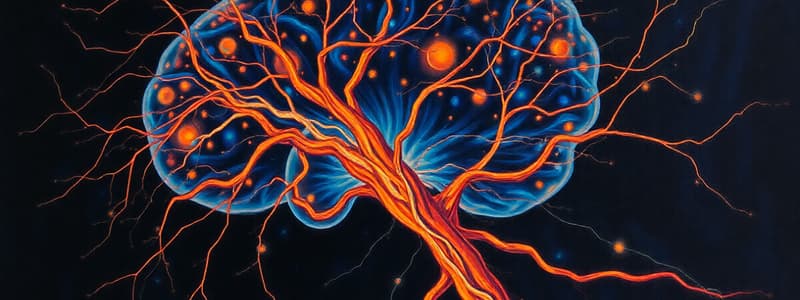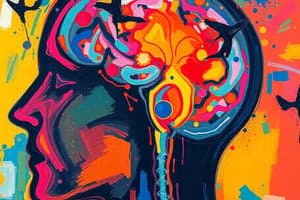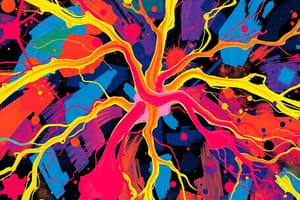Podcast
Questions and Answers
Which of the following is the MOST accurate description of nociception?
Which of the following is the MOST accurate description of nociception?
- The mechanism that causes a person to consciously ignore pain.
- The process by which the nervous system detects and transmits pain signals. (correct)
- The process by which the brain filters out unimportant sensory information.
- The involuntary muscle reaction to damaging stimulation.
During which phase of nociception are nociceptor nerve fibers activated by noxious stimuli?
During which phase of nociception are nociceptor nerve fibers activated by noxious stimuli?
- Transmission
- Modulation
- Perception
- Transduction (correct)
Which of the following is an example of a factor involved in the 'transmission' phase of nociception?
Which of the following is an example of a factor involved in the 'transmission' phase of nociception?
- Conscious awareness of pain in the cerebral cortex.
- Release of endorphins to inhibit pain signals.
- Pain signals traveling along Aδ and C fibers to the dorsal horn of the spinal cord. (correct)
- Activation of Abeta fibers leading to the spinal cord.
In the context of nociception, what is the role of the thalamus, limbic system, and cerebral cortex?
In the context of nociception, what is the role of the thalamus, limbic system, and cerebral cortex?
Which neurotransmitter does NOT inhibit pain signals during the modulation phase of nociception?
Which neurotransmitter does NOT inhibit pain signals during the modulation phase of nociception?
What is the primary function of Abeta fibers in the context of pain modulation?
What is the primary function of Abeta fibers in the context of pain modulation?
Which of the following is an example of a psychological factor that can influence an individual's perception of pain?
Which of the following is an example of a psychological factor that can influence an individual's perception of pain?
How does chronic stress potentially amplify pain perception?
How does chronic stress potentially amplify pain perception?
Which statement BEST describes the role of social factors in pain perception?
Which statement BEST describes the role of social factors in pain perception?
What physiological process underlies peripheral sensitization?
What physiological process underlies peripheral sensitization?
Which of the following is the MOST accurate description of central sensitization?
Which of the following is the MOST accurate description of central sensitization?
Which condition is MOST closely associated with central sensitization?
Which condition is MOST closely associated with central sensitization?
What is the MOST common cause of mechanical lower back pain?
What is the MOST common cause of mechanical lower back pain?
Nerve root compression can cause neuropathic pain. Which of the following conditions causes this?
Nerve root compression can cause neuropathic pain. Which of the following conditions causes this?
Besides osteomyelitis and neoplasms, which condition can contribute to persistent lower back pain?
Besides osteomyelitis and neoplasms, which condition can contribute to persistent lower back pain?
What is the typical duration of acute lower back pain (LBP)?
What is the typical duration of acute lower back pain (LBP)?
A patient reports lower back pain for 5 months. How would this condition be classified?
A patient reports lower back pain for 5 months. How would this condition be classified?
Which of the following symptoms, if reported by a patient with lower back pain, would be considered a 'red flag'?
Which of the following symptoms, if reported by a patient with lower back pain, would be considered a 'red flag'?
A patient with chronic lower back pain expresses a significant fear of movement, leading to increased avoidance of physical activity. According to the material, how would this be classified?
A patient with chronic lower back pain expresses a significant fear of movement, leading to increased avoidance of physical activity. According to the material, how would this be classified?
A groundbreaking medical trial reveals a novel molecular pathway, named the 'Omega-Delta Pathway', directly linking chronic psychological stress to the amplification of pain signals in the dorsal horn of the spinal cord, independent of the HPA axis or limbic system involvement. This pathway's primary mechanism involves the sustained release of a previously unknown neuropeptide, 'Dolorotide,' which selectively sensitizes NMDA receptors on spinal neurons. Which existing therapeutic intervention would MOST LIKELY be effective in mitigating pain in these patients?
A groundbreaking medical trial reveals a novel molecular pathway, named the 'Omega-Delta Pathway', directly linking chronic psychological stress to the amplification of pain signals in the dorsal horn of the spinal cord, independent of the HPA axis or limbic system involvement. This pathway's primary mechanism involves the sustained release of a previously unknown neuropeptide, 'Dolorotide,' which selectively sensitizes NMDA receptors on spinal neurons. Which existing therapeutic intervention would MOST LIKELY be effective in mitigating pain in these patients?
Flashcards
Nociception
Nociception
The process by which the nervous system detects and transmits pain signals, involving transduction, transmission, perception, and modulation.
Transduction (Pain)
Transduction (Pain)
Activation of nociceptor nerve fibers in response to noxious stimuli, resulting in the generation of action potentials.
Transmission (Pain)
Transmission (Pain)
Pain signals travel from primary afferent neurons to the dorsal horn of the spinal cord, then ascend to the brain and thalamus.
Perception (Pain)
Perception (Pain)
Signup and view all the flashcards
Modulation (Pain)
Modulation (Pain)
Signup and view all the flashcards
Peripheral Sensitization
Peripheral Sensitization
Signup and view all the flashcards
Central Sensitization
Central Sensitization
Signup and view all the flashcards
Mechanical Lower Back Pain
Mechanical Lower Back Pain
Signup and view all the flashcards
Neuropathic Pain (Lower Back)
Neuropathic Pain (Lower Back)
Signup and view all the flashcards
Inflammatory/Systemic Causes (LBP)
Inflammatory/Systemic Causes (LBP)
Signup and view all the flashcards
Acute Lower Back Pain
Acute Lower Back Pain
Signup and view all the flashcards
Red Flags (Lower Back Pain)
Red Flags (Lower Back Pain)
Signup and view all the flashcards
Chronic Lower Back Pain
Chronic Lower Back Pain
Signup and view all the flashcards
Yellow Flags (Lower Back Pain)
Yellow Flags (Lower Back Pain)
Signup and view all the flashcards
Study Notes
Nociception Pathways
- Nociception involves the nervous system detecting and transmitting pain signals
- The four key phases of nociception are transduction, transmission, perception, and modulation
Transduction
- Nociceptor nerve fibers activate in response to mechanical, thermal, or chemical stimuli
- This results in action potentials along afferent neurons
- Prostaglandins and substance-P are involved
Transmission
- Pain signals travel from primary afferent neurons to the dorsal horn of the spinal cord
- Aδ fibers transmit fast, acute pain signals
- C fibers transmit slow, continuous, chronic pain signals
- Signals synapse with second-order neurons and ascend to the brain and thalamus via spinothalamic tracts
Perception
- It's a conscious awareness of pain
- It occurs in the thalamus, limbic system, and cerebral cortex
- Involves sensory-discriminative, affective-motivational, and cognitive-evaluative systems
Modulation
- Pain signals are regulated via excitatory and inhibitory mechanisms
- Modulation occurs at multiple levels of the nervous system
- Neurotransmitters like serotonin, epinephrine, and endorphin inhibit pain
- Endogenous opioids like enkephalin and beta-endorphin are also key
- Spinal pathways contribute to the process
- Gate control involves the opening and closing of neural gates to modulate pain
- Abeta fibers activate inhibitory neurons upon touch, providing comfort
Factors Influencing Pain Perception
- Pain perception is influenced by biological, psychological, and social factors
Biological Factors
- Structural changes such as joint degeneration in osteoarthritis, contribute to pain
Psychological Factors
- Mood, stress, and coping mechanisms affect the pain experience
- Chronic stress and emotional distress can amplify pain via the limbic system and the hypothalamic-pituitary-adrenal (HPA) axis
Social Factors
- Social support, cultural beliefs, and healthcare access influence pain
- Stronger social connections often lead to reports of lower pain intensity
Peripheral Sensitization
- It occurs at the site of injury
- Inflammatory mediators lower the threshold for nociceptor activation
- This action makes the affected area more sensitive to pain stimuli
Central Sensitization
- Neurons in the spinal cord and brain show increased excitability
- This leads to amplified pain responses even without peripheral stimuli
- It contributes to chronic pain conditions like fibromyalgia and osteoarthritis
Mechanical Lower Back Pain
- It accounts for 95% of lower back pain (LBP) cases
- Muscle strain, ligament sprain, or intervertebral disc degeneration are the usual causes
- It is non-threatening but can recur and persist if not managed
Neuropathic Pain
- Results from nerve root compression due to herniated discs or spinal stenosis
- It often affects the L5-S1 distribution
Inflammatory and Systemic Causes
- Conditions like osteomyelitis, neoplasms, and inflammatory disorders contribute to persistent lower back pain
Acute Lower Back Pain
- It lasts less than 4 weeks
- Typically associated with muscle or ligament strain
- Presence of localized pain
Chronic Lower Back Pain
- It persists for more than 3 months
- Underlying conditions include degenerative disc disease, spondylolisthesis, or osteoarthritis
Red Flags
- Unexplained weight loss, night pain, history of cancer, or neurological deficits suggest serious pathology
Yellow Flags
- Psychological factors such as fear of movement, depression, and social withdrawal increase the risk of chronic pain.
Studying That Suits You
Use AI to generate personalized quizzes and flashcards to suit your learning preferences.




